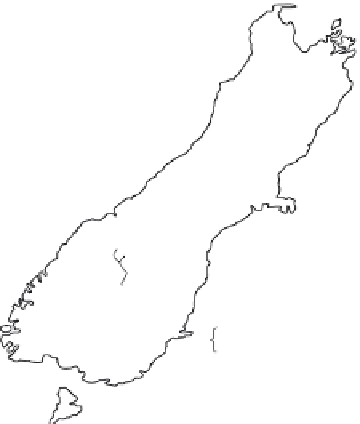Environmental Engineering Reference
In-Depth Information
2.3.2
A species off
the rails -
translocation of the
takahe
Unraveling the fundamental niche of species that have been driven to extreme rarity
may not be straightforward. The takahe (
Porphyrio hochstetteri
), a giant rail, is one
of only two remaining species of the guild of large, fl ightless herbivorous birds that
dominated the pre-human New Zealand landscape. Indeed, it was also believed
extinct until the discovery in 1948 of a small population in the remote and
climatically extreme Murchison Mountains in the southeast of the South Island
(Figure 2.8).
Since then intense conservation efforts have involved habitat management, captive
breeding, wild releases into the Murchison Mountains and nearby ranges, and
translocation to offshore islands that lack the mammals introduced by people and
which are now widespread on the mainland (Lee & Jamieson, 2001). Some ecologists
argued that because the takahe is a grassland specialist (tall tussocks in the genus
Chionochloa
are its most important food) and adapted to the alpine zone it would
not fare well outside this niche (Mills et al., 1984). Others pointed to fossil evidence
that the species was once widespread and occurred mainly at altitudes below 300 m
(often in coa st al are a s; Figure 2.8) where they were associated with a mosaic of
forest, shrublands and grasslands. Thus, takahe might be well suited for life on off-
shore islands that are free of mammalian invaders.
It turned out that the sceptics were wrong in thinking that translocated island
populations would not become self-sustaining (takahe have been successfully intro-
duced to four islands). But they seem to have been right in thinking that islands
would not provide optimal habitat - island birds have poorer hatching and fl edging
success than mountain birds (Jamieson & Ryan, 2001). The fundamental niche of
takahe probably encompasses a large part of the landscape of the South Island, but
Fig. 2.8
Location of
fossil bones of takahe
in the South Island of
New Zealand. The
population had become
restricted to just one
site in the Murchison
Mountains, giving a
misleading picture of its
niche requirements.
(After Trewick &
Worthy, 2001.)
Sims, Mansons, Bone Caves
Paturau
Heaphy River
Honeycomb Hill (6 sites)
Hodge Creek and
Farriers Cave (Mt Arthur)
Metro Cave
Anapai
Rotokura
Aniseed Valley
Walrau
Martells Beach
Waiau
Weka Pass
Timpendean
Waipara
Pyramid Valley
Waikari Cave
Murchison Mountains
(extant population)
Opihi River, Totara Valley
Kings Cave
Tuarangi Stn sites
Mt Harris, Kapua
Ngapara/Totara
Swamp, Enfield
Ototara
Awamoa
Earnscleugh
Macraes
Warrington, Waitati
Long Beach, Kaikais Beach
Ross's Rocks
Castle Rocks
False I.
Pounawea
Cannibal Bay
Tokanni Mouth
Forest Hill
McKerchers Cave
Pahia
Wakapatu
Cotac Bay
Greenhills





















































































Search WWH ::

Custom Search